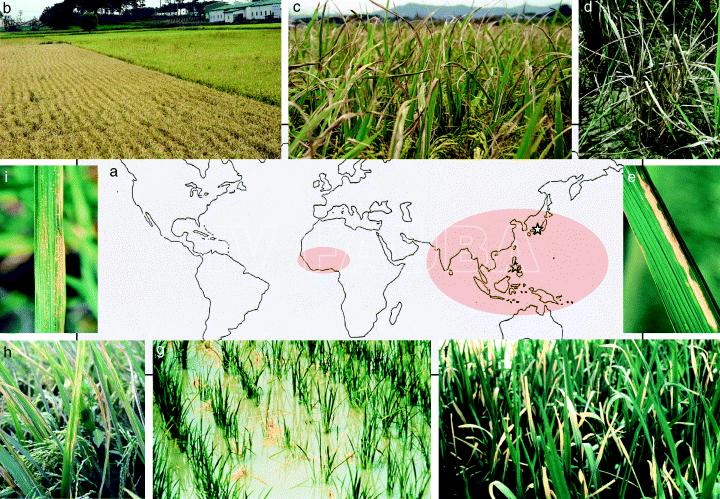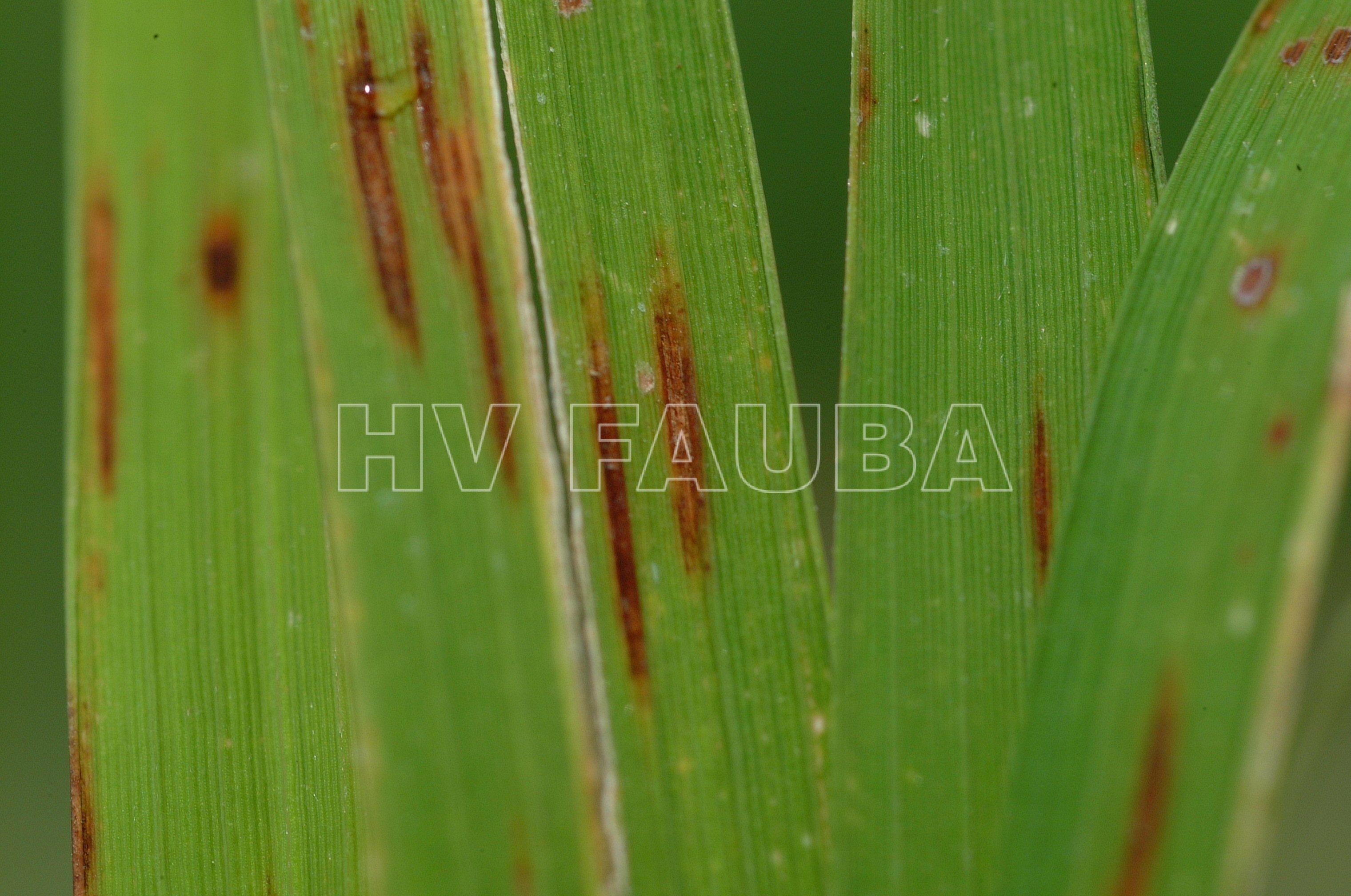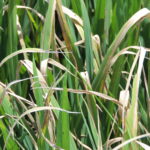.
Condición fitosanitaria: Plaga Cuarentenaria Ausente
Grupo de cultivos: Cereales
Especie hospedante: arroz (Oryza sativa L., 1753)
Etiología: Bacteria. Gram negativa. Considerada hemibiotrófica
Agente causal: Xanthomonas oryzae pv. oryzae; Xanthomonas oryzae pv. oryzicola
Taxonomía: Bacteria > Proteobacteria > Gammaproteobacteria > Xanthomonadales > Xanthomonadaceae > Xanthomonas
.
.
.
Antecedentes
El tizón bacteriano del arroz es una de las enfermedades más graves del arroz. Fue reportada por primera vez en la prefectura de Fukuoka de Japón en 1884 (Niño-Liu et al., 2006). La enfermedad se distribuye tanto en regiones templadas como tropicales.
.
.
- Distribución geográfica y síntomas del tizón bacteriano (TB) y la estría bacteriana de la hoja (EBH, causada por Xanthomonas oryzae pv. oryzicola) del arroz. (b) Parcela de arroz severamente afectada por TB. (c) Plantas de arroz en la fase de maduración que muestran síntomas de TB. (d) TB avanzado. (e) Primer plano de los síntomas de TB. (f) Síndrome de la hoja de color amarillo pálido causado por el patógeno TB. (g) Tizón de las plántulas o síndrome de «kresek» causado por el patógeno TB. (h) EBH. (i) Primer plano de los síntomas de EBH; las gotas de exudado bacteriano crean una apariencia punteada. Autor: Niño-Liu et al., 2006.
.
.
Sintomatología
.
- Autor: Syed Atif Hasan Naqvi et al. (2014)
.
- Fuente: © Online Plant Clinic
- Fuente: © Online Plant Clinic
- Fuente: © Online Plant Clinic
- Fuente: © Online Plant Clinic
.
.
Manejo Integrado
* Sembrar variedades resistentes
* Uso adecuado de fertilizantes, especialmente nitrógeno.
* Saneamiento: eliminar malezas hospedantes, y plantas guachas de arroz
* Mantener el nivel del agua bajo durante el período de inundaciones severas
* Control químico
* Inducción de defensas naturales
.
.
.
Bibliografía
A X, Yang Y, Chen X, et al. (2023) Complete Genome Resource of a Hypervirulent Xanthomonas oryzae pv. oryzae Strain YNCX Isolated From Yunnan Plateau Japonica Rice. Plant Disease. doi: 10.1094/PDIS-04-23-0674-A
Chen X, Dong Y, Yu C, et al. (2016) Analysis of the Proteins Secreted from the Oryza meyeriana Suspension-Cultured Cells Induced by Xanthomonas oryzae pv. oryzae. PLoS ONE 11(5): e0154793. doi: 10.1371/journal.pone.0154793
Chen X, Sun C, Laborda P, et al. (2019) Melatonin treatments reduce the pathogenicity and inhibit the growth of Xanthomonas oryzae pv. oryzicola. Plant Pathol 68: 288-296. doi: 10.1111/ppa.12954
Chukwu SC, Rafii MY, Ramlee SI, et al. (2019) Bacterial leaf blight resistance in rice: a review of conventional breeding to molecular approach. Mol Biol Rep 46: 1519–1532. doi: 10.1007/s11033-019-04584-2
Costa J, Pothier JF, Boch J, et al. (2021) Integrating science on Xanthomonadaceae for sustainable plant disease management in Europe. Mol Plant Pathol. 22(12): 1461-1463. doi: 10.1111/mpp.13150
Dharmapuri S, Sonti RV (1999) A transposon insertion in the gumG homologue of Xanthomonas oryzae pv. oryzae causes loss of extracellular polysaccharide production and virulence. FEMS Microbiol Lett 179 (1): 53‐9. doi: 10.1111/j.1574-6968.1999.tb08707.x
Domingo-Calap ML, Bernabéu-Gimeno M, Aure MC, et al. (2022) Comparative Analysis of Novel Lytic Phages for Biological Control of Phytopathogenic Xanthomonas spp. Microbiol Spectr. e0296022. doi: 10.1128/spectrum.02960-22
Feng JX, Song ZZ, Duan CJ, et al. (2009) The xrvA gene of Xanthomonas oryzae pv. oryzae, encoding an H‐NS‐like protein, regulates virulence in rice. Microbiology 155 (Pt 9): 3033‐44. doi:
Feng Q, Wang H, Yang X-M, et al. (2022) Osa-miR160a confers broad-spectrum resistance to fungal and bacterial pathogens in rice. New Phytol. doi: 10.1111/nph.18491
Furutani A, Tsuge S, Ohnishi K, et al. (2004) Evidence for HrpXo‐dependent expression of type II secretory proteins in Xanthomonas oryzae pv. oryzae. J Bacteriol 186 (5): 1374‐80. doi: 10.1128/JB.186.5.1374-1380.2004
Gao M, He Y, Yin X, et al. (2021) Ca2+ sensor-mediated ROS scavenging suppresses rice immunity and is exploited by a fungal effector. Cell 184: 5391-5404.e17. doi: 10.1016/j.cell.2021.09.009
Haq F, Xu X, Ma W, et al. (2021) A Xanthomonas transcription activator-like effector is trapped in nonhost plants for immunity. Plant Communications. doi: 10.1016/j.xplc.2021.100249
Hata EM, Sijam K, Yusof MT, et al. (2019) Occurrence of Xanthomonas oryzae pv. oryzicola causing bacterial leaf streak disease of rice in different state of Malaysia. J Plant Pathol 101: 785–786. doi: 10.1007/s42161-019-00254-1
He YW, Wu J, Cha JS, et al. (2010) Rice bacterial blight pathogen Xanthomonas oryzae pv. oryzae produces multiple DSF‐family signals in regulation of virulence factor production. BMC Microbiol 10: 187. doi: 10.1186/1471-2180-10-187
Jalilian A, Bagheri A, Chalvon V, et al. (2023) The RLCK subfamily VII-4 controls pattern-triggered immunity and basal resistance to bacterial and fungal pathogens in rice. Plant J. doi: 10.1111/tpj.16323
Kametani‐Ikawa Y, Tsuge S, Furutani A, Ochiai H (2011) An H‐NS‐like protein involved in the negative regulation of hrp genes in Xanthomonas oryzae pv. oryzae. FEMS Microbiol Lett 319 (1): 58‐64. doi: 10.1111/j.1574-6968.2011.02266.x
Khan MA, Naeem M, Iqbal M (2014) Breeding approaches for bacterial leaf blight resistance in rice (Oryza sativa L.), current status and future directions. Eur J Plant Pathol 139: 27–37. doi: 10.1007/s10658-014-0377-x
Kim SY, Kim JG, Lee BM, Cho JY (2009) Mutational analysis of the gum gene cluster required for xanthan biosynthesis in Xanthomonas oryzae pv oryzae. Biotechnol Lett 31(2): 265‐70. doi: 10.1007/s10529-008-9858-3
Lang JM, Pérez-Quintero AL, Koebnik R, et al. (2019) A Pathovar of Xanthomonas oryzae Infecting Wild Grasses Provides Insight Into the Evolution of Pathogenicity in Rice Agroecosystems. Front. Plant Sci. 10: 507. doi: 10.3389/fpls.2019.00507
Lee SW, Han SW, Bartley LE, Ronald PC (2006) Unique characteristics of Xanthomonas oryzae pv. oryzae AvrXa21 and implications for plant innate immunity. Proceedings of the National Academy of Sciences 103 (49): 18395-18400. doi: 10.1073/pnas.0605508103
Lee SW, Jeong KS, Han SW, et al. (2008) The Xanthomonas oryzae pv. oryzae PhoPQ two-component system is required for AvrXA21 activity, hrpG expression, and virulence. J Bacteriol. 190(6): 2183-97. doi: 10.1128/JB.01406-07
Li W, Xu Y-P, Zhang Z-X, et al. (2012) Identification of Genes Required for Nonhost Resistance to Xanthomonas oryzae pv. oryzae Reveals Novel Signaling Components. PLoS ONE 7(8): e42796. doi: 10.1371/journal.pone.0042796
, , , et al. (2020) The Xanthomonas oryzae pv. oryzae type IV pilus alignment subcomplex protein PilN contributes to regulation of bacterial surface-associated behaviours and T3SS system. Plant Pathol. 69: 744– 755. doi: 10.1111/ppa.13157
Lu W, Pan L, Zhao H, et al. (2014) Molecular detection of Xanthomonas oryzae pv. oryzae, Xanthomonas oryzae pv. oryzicola, and Burkholderia glumae in infected rice seeds and leaves. The Crop Journal 2: 398-406. doi: 10.1016/j.cj.2014.06.005
Ma W, Zou L, Zhiyuan J, et al. (2018), Xanthomonas oryzae pv. oryzae TALE proteins recruit OsTFIIAγ1 to compensate for the absence of OsTFIIAγ5 in bacterial blight in rice. Molecular Plant Pathology 19: 2248-2262. doi: 10.1111/mpp.12696
Ma Y, Yang J, Dong J, et al. (2022) Overexpression of OsGF14f Enhances Quantitative Leaf Blast and Bacterial Blight Resistance in Rice. Int J Mol Sci. 23(13): 7440. doi: 10.3390/ijms23137440
Majumdar TD, Singh M, Thapa M, et al. (2019) Size-dependent antibacterial activity of copper nanoparticles against Xanthomonas oryzae pv. oryzae – A synthetic and mechanistic approach. Colloid and Interface Science Communications 32: 100190. doi: 10.1016/j.colcom.2019.100190
Mei Q, Yang Y, Ye S, et al. (2019) H2O2 Induces Association of RCA with the Thylakoid Membrane to Enhance Resistance of Oryza meyeriana to Xanthomonas oryzae pv. oryzae. Plants 8(9): 351. doi: 10.3390/plants8090351
Naqvi SAH et al. (2014) Determination of antibacterial activity of various broad spectrum antibiotics against Xanthomonas oryzae pv. oryzae, a cause of bacterial leaf blight of rice. International Journal of Microbiology and Mycology 2: 12-19. pISSN: 2309-4796. Link
Niño-Liu DO, Ronald PC, Bogdanove AJ (2006) Xanthomonas oryzae pathovars: model pathogens of a model crop. Molecular Plant Pathology 7: 303-324. doi: 10.1111/j.1364-3703.2006.00344.x
Niño MC, Cho Y-G (2020) Transcriptional Modulation of Resistance against Xanthomonas oryzae pv. oryzae Korean Race K2 in japonica Rice. Agronomy 10(7): 960. doi: 10.3390/agronomy10070960
Nugroho C, Cumagun CJR, Oliva R (2022) Diversity of Xanthomonas oryzae pv. Oryzae on susceptible and resistant rice lines in bacterial blight hot spot areas of the Philippines. Eur J Plant Pathol. doi: 10.1007/s10658-022-02531-9
Pan X, Wu J, Xu S, et al. (2017) CatB is Critical for Total Catalase Activity and Reduces Bactericidal Effects of Phenazine-1-Carboxylic Acid on Xanthomonas oryzae pv. oryzae and X. oryzae pv. oryzicola. Phytopathology. 107(2): 163-172. doi: 10.1094/PHYTO-07-16-0251-R
Rajeshwari R, Jha G, Sonti RV (2005) Role of an in planta‐expressed xylanase of Xanthomonas oryzae pv. oryzae in promoting virulence on rice. Mol Plant Microbe Interact 18(8): 830‐7. doi: 10.1094/MPMI-18-0830
Rajarajeswari NVL, Muralidharan K (2006) Assessments of farm yield and district production loss from bacterial leaf blight epidemics in rice. Crop Prot. 25: 244–252. doi: 10.1016/j.cropro.2005.04.013
Rajer FU, Samma MK, Ali Q, et al. (2022) Bacillus spp.-Mediated Growth Promotion of Rice Seedlings and Suppression of Bacterial Blight Disease under Greenhouse Conditions. Pathogens 11(11): 1251. doi: 10.3390/pathogens11111251
Ray SK, Rajeshwari R, Sonti RV (2000) Mutants of Xanthomonas oryzae pv. oryzae deficient in general secretory pathway are virulence deficient and unable to secrete xylanase. Mol Plant Microbe Interact 13(4): 394‐401. doi: 10.1094/MPMI.2000.13.4.394
Sahu SK, Zheng P, Yao N (2018) Niclosamide Blocks Rice Leaf Blight by Inhibiting Biofilm Formation of Xanthomonas oryzae. Front. Plant Sci. 9: 408. doi: 10.3389/fpls.2018.00408
, , , et al. (2022) Transcriptional regulator Sar regulates the multiple secretion systems in Xanthomonas oryzae. Molecular Plant Pathology 00: 1– 12. doi: 10.1111/mpp.13272
, , (2021) The diffusible signal factor synthase, RpfF, in Xanthomonas oryzae pv. oryzae is required for the maintenance of membrane integrity and virulence. Molecular Plant Pathology 00: 1– 15. doi: 10.1111/mpp.13148
Sun QJ, Hu J, Huang GX, et al. (2005) Type II secretion pathway structural gene xpsE, xylanase and cellulase secretion and virulence in Xanthomonas oryzae pv. oryzae. Plant Pathology 54: 15‐21. doi: 10.1111/j.1365-3059.2004.01101.x
Tayi L, Kumar S, Nathawat R, et al. (2018), A mutation in an exoglucanase of Xanthomonas oryzae pv. oryzae, which confers an endo mode of activity, affects bacterial virulence, but not the induction of immune responses, in rice. Molecular Plant Pathology 19: 1364-1376. doi: 10.1111/mpp.12620
Teper D, White FF, Wang N (2023) The Dynamic Transcription Activator-Like Effector Family of Xanthomonas. Phytopathology 113(4): 651-666. doi: 10.1094/PHYTO-10-22-0365-KD
Tian Y, Zhao Y, Xu R, et al. (2014) Simultaneous Detection of Xanthomonas oryzae pv. oryzae and X. oryzae pv. oryzicola in Rice Seed Using a Padlock Probe‐Based Assay. Phytopathology 104 (10): 1130‐7. doi: 10.1094/PHYTO-10-13-0274-R
Wang L, Vinogradov EV, Bogdanove AG (2013) Requirement of the Lipopolysaccharide O‐Chain Biosynthesis Gene wxocB for Type III Secretion and Virulence of Xanthomonas oryzae pv. oryzicola. Journal of Bacteriology 195 (9): 1959–1969. doi: 10.1128/JB.02299-12
Wang B, He B, Chen T, et al. (2022) Discovery of Tropolone Stipitaldehyde as a Potential Agent for Controlling Phytophthora Blight and Its Action Mechanism Research. J Agric Food Chem. doi: 10.1021/acs.jafc.2c03163
Wang C, Zhang X, Fan Y, et al. (2015) XA23 is an executor R protein and confers broad-spectrum disease resistance in rice. Mol Plant. 8(2): 290-302. doi: 10.1016/j.molp.2014.10.010
Wang W, Feng M, Li X, et al. (2022) Antibacterial Activity of Aureonuclemycin Produced by Streptomyces aureus Strain SPRI-371. Molecules 27(15): 5041. doi: 10.3390/molecules27155041
, , , et al. (2023) NIT24 and NIT29-mediated IAA synthesis of Xanthomonas oryzae pv. oryzicola suppresses immunity and boosts growth in rice. Molecular Plant Pathology 00: 1–13. doi: 10.1111/mpp.13409





